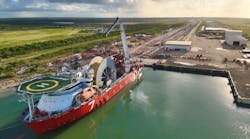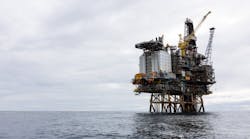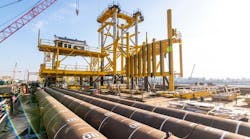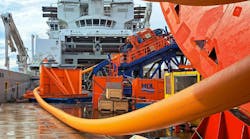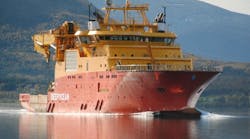One key is flexibility in the control system
Allen Rentcome
Rick McLin
Rockwell Automation
Oil and gas companies involved in the development of subsea technology estimate that in addition to increasing overall field recovery by up to 20%, subsea production solutions like the pilot compressor installations offer the potential to reduce capital expenditures by 30 to 40%, and overall operating costs by up to half.
Scalable controllers give multiple redundancies required for safe subsea production.
With subsea facilities designed to feed directly into onshore production facilities, oil and gas producers do not require any topside structure. As a result, they can improve safety by reducing the number of personnel needed to operate the facility and by reducing negative impact from weather. They also will be able to expand exploration and production into even less hospitable regions.
While the pilot projects currently under way focus primarily on compressor control, many leading oil and gas companies see potential for similar control systems to be used for a range of future subsea applications, including gas separation, high integrity pressure protection system (HIPPS) control, and water disposal.
World demand for oil and gas shows no signs of diminishing. In fact, the US Energy Information Administration reports that world-marketed energy consumption is projected to increase by 49% from 2007 to 2035. Production of crude oil, however, may have a difficult time keeping up with the pace of demand. According to the International Energy Agency’s 2009 “World Energy Outlook,” crude oil production from existing fields will drop by almost two-thirds by the year 2030. In addition, it is anticipated that oil and gas companies will need an additional 2.7 tcm (95 tcf) of natural gas capacity just to keep up with the demand for this energy resource.
To compound the problem, there is no such thing as “easy oil” anymore. Demand has pushed exploration and production further and further out to sea. By moving further offshore, producers face new technological and mechanical challenges.
There also are environmental and safety risks. For example, deepwater platforms often require helicopter transportation for supplies and staff, which has relatively high risk, according to the International Association of Oil and Gas Producers.
In addition, deepwater production platforms are vulnerable to catastrophic events ranging from explosions to ship collisions. They are capital intensive, too. It typically costs more than $1 billion to operate a production platform over a 10 to 20-year life cycle.
Subsea could be the answer
As operations move further offshore, the potential gains increase, but the risks increase as well. Due to the loss of pressure caused by production, some hydrocarbons are simply non-recoverable – there is not enough natural pressure to push the oil and gas to the surface. It is estimated that by moving production to the seabed and thereby decreasing the amount of pressure needed to extract the reserves, oil and gas companies could recover up to 20% more from producing fields. In addition, subsea production facilities can cost up to 50% less to operate than surface platforms due to the decrease in topside staff and supplies.
The implications for the boost in recovery combined with the reduction in capital investment are huge. Companies could explore smaller, deeper fields that might not otherwise be economically viable. Subsea systems could produce reserves found in harsh environments not conducive to a topside production platform. In short, oil and gas companies could access the additional resources necessary to serve the enormous global demand.
Technology challenges
While companies have long anticipated the potential benefits of subsea production, reality has prevented it from happening. Until recently, the idea of building an entire production facility thousands of feet under the sea probably did not seem much different than building one on the Moon. While many could see the opportunity, the technology was not available to produce in an unmanned, complex environment 3,000 m (≈10,000 ft) below the surface.
However, over the past 10 years, oil and gas producers around the globe have started to develop pilot subsea compression stations. If these pilot projects prove successful, the reality of subsea compression has the potential to eliminate the need for – and risks associated with – a production platform.
Companies participating in various pilot projects understand the potential economic, safety, and environmental benefits subsea production represents. At the same time, cutting-edge compression technology has matured to the point that it is ready to be marinized, miniaturized, and ruggedized for the pressure constraints, corrosive environment and frigid temperatures that exist subsea.
The latest subsea compression systems typically measure 12 m (40 ft) high, 35 m (115 ft) wide, and 49 m (160 ft) long. An installation this size is required to allow room for ROV assistance in system maintenance.
The complexities of the system also require some of the most technologically advanced equipment available. Equipment on the systems include multiple compressor trains, variable speed motors, separate vessels and coolers, pump and level controls, transformers, electronics and liquid slug and MEG handling – each thoroughly tested and designed specifically for the subsea environment.
Brains behind the brawn
To control giant subsea platforms, oil and gas companies need closed-loop controllers to help protect against pressure surges that could cause catastrophic failures in the expensive compressors. This system also requires a controller that matches the Eurocard circuit board format that fits in existing subsea-qualified enclosures, to save the time and expense associated with designing and testing an entirely new enclosure usable at extreme depths.
Operators typically test machinery and components from many sources to identify as many potential components as possible. This helps the company identify the best-in-class solutions most likely to hold up in such intense conditions, prior to installing the system subsea.
To communicate with this variety of devices, the control system must leverage a standard programming environment. The end user also requires that the control solution feature simplex, redundant, or triple modular redundancy levels depending upon each supplier’s specifications.
As companies look toward executing this cutting-edge approach, it is important to look for a control architecture that offers dual, closed-loop independent subsea electronics modules (SEMs), each with a redundant central processing unit (CPU) for improved availability. This also provides physical separation to minimize loss of contact during safety events, along with multiple Ethernet channels to onshore operations. The control system should support online reconfiguration, such as adjustment of input thresholds, without necessitating a process shutdown; and it should be built for IEC-61131 compliance with integral support for all five programming languages.
Subsea controller
The AADvance controller from Rockwell Automation has been used in several subsea compressor control applications to provide the multiple redundancy levels required. Its scalable design allows oil and gas producers to add up to 48 I/O modules if necessary, and is based on commercially available, off-the-shelf technology. This allows the end user – and the many companies involved in a project – to focus on design rather than customized programming and engineering.
An automation engineering team also modifies the electronics to fit a Eurocard circuit board format, which fits in subsea-rated enclosures rated to a depth of 3,000 m (approx. 9,800 ft). The modification then receives thermal testing ranging from -20° to +70° C (-4° to +158° F), as well as severe vibration testing on special test jigs.
Offshore Articles Archives
View Oil and Gas Articles on PennEnergy.com


